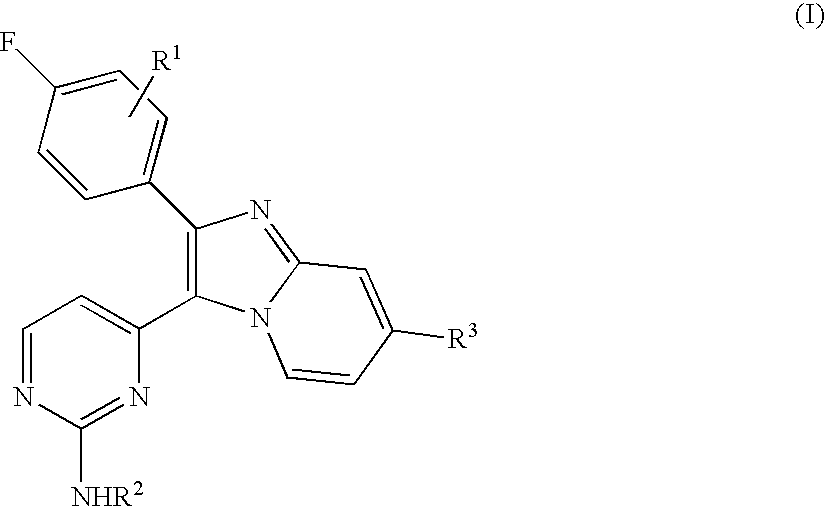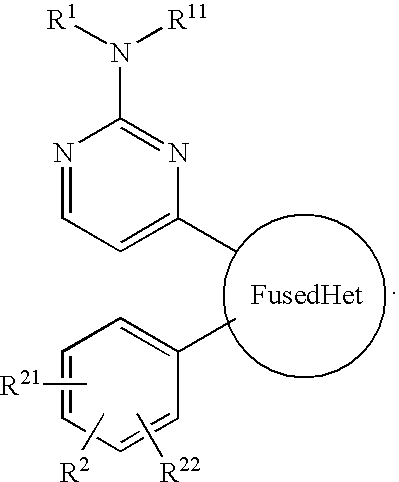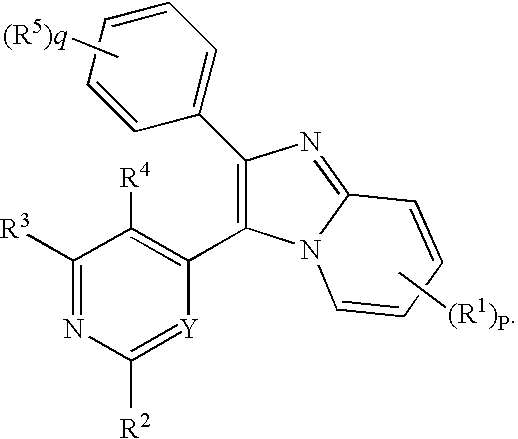Antiprotozoal imidazopyridine compounds
a technology of imidazopyridine and compound, which is applied in the field of imidazopyridine, can solve the problems of malaria remaining a significant health threat to humans, anti-coccidial agents such as sulfanilamides, nitrofurans, benzoamides, etc., and achieve the effect of treating protozoal diseases, and preventing protozoal diseases
- Summary
- Abstract
- Description
- Claims
- Application Information
AI Technical Summary
Benefits of technology
Problems solved by technology
Method used
Image
Examples
example 1
4-[7-(2-Aminoethyl)-2-(4-fluorophenyl)imidazo[1,2-a]pyridin-3-yl]pyrimidin-2-amine (24)
[0096]
Step 1: 4-Methyl-2-(methylthio)pyrimidine (2)
[0097] A 22 L round bottom flask equipped with an air stirrer, heating mantle, thermometer, and reflux condenser was charged with toluene (12 L), 2-mercapto-4-methylpyrimidine hydrochloride (1) (900 g, 5.53 mol), diisopropylethylamine (1.07 kg, 8.30 mol), and N,N-dimethylformamide dimethyl acetal (1.61 kg, 12.7 mol). The reaction mixture was heated to reflux for 3.5 hours, and then the red solution was concentrated under reduced pressure to remove toluene, methanol, and some N,N-dimethylformamide. The residue was then treated with ethyl acetate (2 L), water (2 L), and enough 10% (w / v) aqueous sodium bisulfate solution to reach a pH of 4.5. After mixing, the organic layer was siphoned into a separate container, and the aqueous layer was extracted with additional ethyl acetate (2×2 L). All organic extracts were combined, dried over sodium sulfate,...
example 2
4{7-[2-(Dimethylamino)ethyl]-2-(4-fluorophenyl)imidazo[1,2-a]pyridin-3-yl}-pyrimidin-2-amine (25)
[0106]
Step 1: 4-{7-[2-(Dimethylamino)ethyl]-2-(4-fluorophenyl)imidazo[1,2-a]pyridin-3-yl}pyrimidin-2-amine (25)
[0107] A 28 mL Pyrex-Plus tube containing the product of Example 1, Step 9 (30 mg, 0.086 mmol) was charged with methanol (1.0 mL), then acetic acid (33 □L), then formaldehyde (28 mg of a 37% aqueous solution, 0.34 mmol), then NaBH3CN (431 □L of a 1.0M solution in THF, 0.431 mmol), and stirred at room temperature for 12 hours. A separate 28 mL Pyrex-Plus tube containing the product of Example 1, Step 9 (70 mg, 0.20 mmol) was charged with methanol (2.0 mL), then acetic acid (67 □L), then formaldehyde (65 mg of a 37% aqueous solution, 0.80 mmol), then NaBH3CN (1.00 mL of a 1.0M solution in THF, 1.00 mmol), and stirred at room temperature for 2 hours. Both reaction mixtures were then combined, along with 50 mgs of crude product prepared previously then concentrated under reduced p...
example 3
4-[7-(2-Amino-1,1-dimethylethyl)-2-(4-fluorophenyl)imidazo[1,2-a]pyridin-3-yl]-pyrimidin-2-amine (28)
[0108]
Step 1: 2-{2-(4-Fluorophenyl)-3-[(2-methylsulfanyl)pyrimidin-4-yl]imidazo-[1,2-a]pyridin-7-yl}-2-methylpropanenitrile (8)
[0109] To a 500 mL round bottom flask was added nitrile 7 (3.70 g, 9.85 mmol) and THF (200 mL), and the flask was cooled in an ice-water bath. Sodium hydride (1.18 g of 60% wlw sample in mineral oil, 29.6 mmol) was then added in portions, followed by the addition of methyl iodide (3.08 g, 21.7 mmol). The reaction mixture was allowed to warm to room temperature. After stirring for 30 minutes, the reaction was quenched with 100 mL water, and then extracted into 3×200 mL ethyl acetate. The organic fractions were pooled, dried over Na2SO4, filtered, and concentrated under reduced pressure. The resulting residue was dissolved in a minimum volume of methylene chloride, then loaded onto a silica plug and chromatographed with 1.0 L heptane, and then 2.0 L 50:50 eth...
PUM
 Login to View More
Login to View More Abstract
Description
Claims
Application Information
 Login to View More
Login to View More - R&D
- Intellectual Property
- Life Sciences
- Materials
- Tech Scout
- Unparalleled Data Quality
- Higher Quality Content
- 60% Fewer Hallucinations
Browse by: Latest US Patents, China's latest patents, Technical Efficacy Thesaurus, Application Domain, Technology Topic, Popular Technical Reports.
© 2025 PatSnap. All rights reserved.Legal|Privacy policy|Modern Slavery Act Transparency Statement|Sitemap|About US| Contact US: help@patsnap.com



